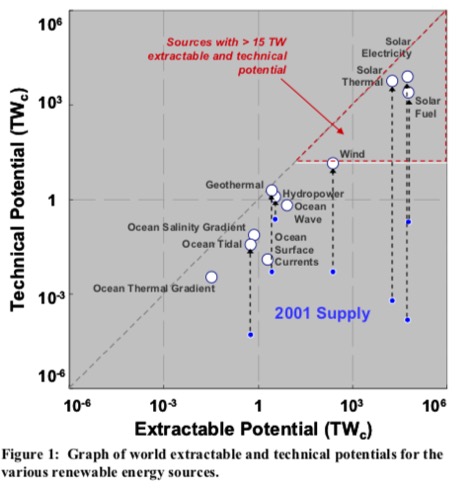Solar with a sprinkling of nuclear ~ What’s realistic?
This 2006 Sandia Labs paper focuses on world energy needs and suggests ways to become carbon neutral.
Sandia scientists have worked extensively on nuclear and solar energy research. Experts within and outside of Sandia contributed to this paper which is well worth reading. Their website also has a great deal of information.
Whatever you think about nuclear energy, nuclear power does not currently have the capacity to solve our energy problems. We cannot build the number of reactors needed to both capture and sequester the necessary amount of carbon in time. More importantly there is not enough uranium to power them for more than ten years. (See specifics below)
Their conclusion is that only solar has the potential scale to meet this challenge.
What are the world’s energy needs?
Projected world energy consumption per year:
• 2001 – 13.5 TW
• 2050 – 27.6 TW
• 2100 – 43 TW
• The world’s current yearly total energy requirements are 15TW per year.
(TW: terawatt = 1 trillion watts = 10 billion 100 watt light bulbs running simultaneously)
Projected Carbon emissions:
• 2001 – 6.6 GtC
• 2050 – 11.0 GtC
• 2100 – 113.3 GtC
(1 Gt: gigatonne = 3.67 Gt CO2)
Based on the ocean’s ability to absorb CO2, all future emissions must be absolutely limited to 1-2 GtC/yr.
This requires that emissions do not exceed the 6.6 GtC/yr level of 2001 emissions.
An important conclusion of the paper is to act now. If we wait to go C-neutral the problem becomes much harder.
We need about 15TW of total energy in the form of carbon neutral energy in order to stop emissions.
Could all of Earth’s needs for C-neutral power be derived from fossil fuels?
Not easily. All CO2. output from fossil-fuel power plants would need to be sequestered.
Could all of Earth’s C-neutral power be derived from sources that produce electricity?
No. Electricity is considered to be “high-grade” form of energy and is 3x more expensive than energy burned directly to power vehicles or heat houses. To be cost-competitive with current fuels, the price would have to be reduced to $0.02/kWh.
A worldwide adoption of a carbon tax would change this equation and make alternative energy sources cost-competitive. Since electricity would need to be used to generate fuels that are portable, an additional 1-3x in cost reduction may be necessary.
Some challenges associated with supplying C-neutral nuclear power
To produce 15 TW by 2050 would require roughly 14,636 new 1-GWe nuclear power plants. Construction of this number of plants would require, on average, the commissioning of a new nuclear power plant somewhere in the world every day continuously for 40 years.
These “slow-neutron” style reactors are:
• very expensive to build,
• require huge amounts of energy during construction.
• have safety issues,
• there is also only enough uranium in the earth to power these plants for 10 years once they are all operational.
So, it is extremely unlikely that traditional nuclear technology can solve the problem.
However, the development of new “fast-breeder” reactor designs may change this equation. Fast-breeder reactors generate their own fuel as they run, therefore availability of uranium would not be a problem. Numerous people are funding efforts to develop such technology.
Which renewable energy resources have the greatest potential for supplying 15 TW of C-neutral power?
The paper includes an excellent analysis of this question, investigating the various forms of renewable energy, including solar (photovoltaic, concentrated, and biomass), wind, ocean waves, and geothermal.
The conclusion of the analysis is clear – only solar has the potential to scale to meet this challenge.
What is the potential of solar energy?
The sun delivers more energy to Earth in an hour than we use in a year from fossil, nuclear and all renewable resources combined! Good news!
This theoretical potential could be used to generate 15 TW of C-neutral power from 10%- efficient solar-conversion systems covering only 0.17% of the Earth’s surface area.
To supply the (smaller) power that the U.S. consumed in 2001 (3.24 TW) with similarly efficient solar conversion systems would require a correspondingly smaller surface area. This is roughly 1.9% of the surface area (9,631,418 km2), and 2.0% of the land area (9,161,923 km2), of the U.S.
It is also roughly 30 times the total roof space (5,800 km2) that was estimated to be available in 2003 for photovoltaics in the U.S. It is comparable to the 1-1.5% of the U.S. land area that is covered by the nation’s public roads; and is comparable to the land area of North Dakota (178,694 km2) or South Dakota (196,576 km2).
Altogether, the technical potentials can be estimated to be:
• Solar electricity: 89,000 TWc · (1-0.708) · (1-0.0345) · (0.3) = 7,500 TWc
• Solar fuels: 89,000 TWc · (1-0.708) · (1-0.0345) · (0.1) = 2,500 TWc
• Solar thermal: 89,000 TWc · (1-0.708) · (1-0.0345) · (0.225) = 5,600 TWc
An important chart from the paper






